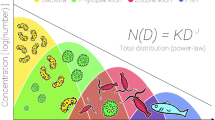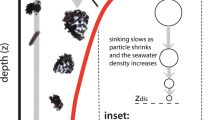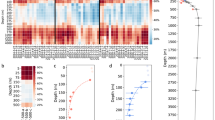Abstract
PARTICULATE matter plays an important part in biogeochemical cycles in the ocean; as particles settle out of the water column, they carry with them carbon and other adsorbed chemicals. Because particles of sub-micrometre size (at the boundary between 'particulate' and 'dissolved' materials) do not have appreciable settling rates in natural waters, they have generally been considered unimportant in the downward flux of particles and the nature and origin of the particles are largely unknown1–5. Here we present results from epifluorescence microscopy and from particle counting which have allowed us to determine the vertical distribution of sub-micrometre particles (size range 0.38–1 µm). We find that >95% of these particles are non-living and occur in the upper layers of the ocean (50 m) in concentrations of the order of 10 million per millilitre. Many of the non-living particles seem to be fragile and flexible, and seem to have a high water content and to be composed largely of organic material. The size distribution of these sub-micrometre particles leads us to conclude that a significant portion (at least 10%) of 'dissolved' organic material may in fact be in the form of these small particles, as suggested by Sharp6.
This is a preview of subscription content, access via your institution
Access options
Subscribe to this journal
Receive 51 print issues and online access
$199.00 per year
only $3.90 per issue
Buy this article
- Purchase on Springer Link
- Instant access to full article PDF
Prices may be subject to local taxes which are calculated during checkout
Similar content being viewed by others
References
Johnson, P. W., Sieburth, J. McN. Limnol. Oceanogr. 24, 928–935 (1979).
Gordon, D. C. Deep Sea Res. 17, 175–185 (1970).
Mel'nikov, I. A. Oceanol. Acad. Sci. U.S.S.R. 15, 182–186 (1976).
Mel'nikov, I. A. Oceanol. Acad. Sci. U.S.S.R. 16, 401–403 (1977).
Rassoulzadegan, F. & Sheldon, R. W. Limnol. Oceanogr. 31, 1010–1021 (1986).
Sharp, J. H. Limnol. Oceanogr. 18, 441–447 (1973).
Hattori, A. (ed.) Preliminary Report of the Hakuho Maru Cruise KH-86-3 (1986).
Kogure, K. & Koike, I. Appl. envir. Microbiol. 53, 274–277 (1987).
Hobbie, J. E. et al. Appl envir Microbiol. 33, 1225–1228 (1977).
Porter, K. G. & Feig, Y. S. Limnol. Oceanogr. 25, 943–948 (1980).
Li, W. K. W. in Photosynthetic picoplankton, Can. Bull. Fish. aquatic Sci. 251–286 (1986).
Shanks, S. L. & Trent, J. D. Limnol. Oceanogr. 24, 850–854 (1979).
Shanks, S. L. & Trent, J. D. Deep Sea Res. 27, 137–143 (1980).
MacKinnon, M. D. in Marine Organic Chemistry (eds Duursma E. K. & Dawson, R.) 415–443 (Elsevier, Amsterdam, 1981).
Sugimura, Y. & Suzuki, Y. Mar. Chem. 24, 105–131 (1988).
Author information
Authors and Affiliations
Rights and permissions
About this article
Cite this article
Isao, K., Hara, S., Terauchi, K. et al. Role of sub-micrometre particles in the ocean. Nature 345, 242–244 (1990). https://doi.org/10.1038/345242a0
Received:
Accepted:
Issue Date:
DOI: https://doi.org/10.1038/345242a0
This article is cited by
-
Diurnal changes in bacterial communities in oxic surface and hypoxic middle seawater layers of the Changjiang River Estuary
Acta Oceanologica Sinica (2021)
-
A non-lethal method for detection of Bonamia ostreae in flat oyster (Ostrea edulis) using environmental DNA
Scientific Reports (2020)
-
Bacterioplankton drawdown of coral mass-spawned organic matter
The ISME Journal (2018)
-
Estimation of carbon biomass and community structure of planktonic bacteria in Lake Biwa using respiratory quinone analysis
Limnology (2013)
-
The influence of Phaeocystis globosa on microscale spatial patterns of chlorophyll a and bulk-phase seawater viscosity
Biogeochemistry (2007)
Comments
By submitting a comment you agree to abide by our Terms and Community Guidelines. If you find something abusive or that does not comply with our terms or guidelines please flag it as inappropriate.



